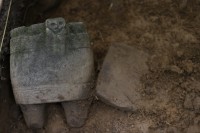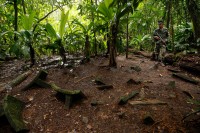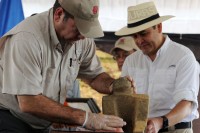 Archaeologists have begun to excavate an ancient site that may be the kernel of truth inside the legends of the lost White City in the tropical rainforest of the Misquitia region on the eastern Mosquito Coast of Honduras. The local Pech and Payas peoples have an oral tradition transmitted through the generations of a forbidden city with large buildings built from local white limestone. Spanish Bishop Cristobal de Pedraza wrote about the tale of the lost in a letter King Charles V of Spain in 1544. He said he’d seen a large city in a river valley while traveling through the jungle. His guides told him the nobles there ate on plates made of pure gold. For hundreds of years explorer searched for it, some even claimed to have found it, reporting fantastical finds of gold idols and carved white stones.
Archaeologists have begun to excavate an ancient site that may be the kernel of truth inside the legends of the lost White City in the tropical rainforest of the Misquitia region on the eastern Mosquito Coast of Honduras. The local Pech and Payas peoples have an oral tradition transmitted through the generations of a forbidden city with large buildings built from local white limestone. Spanish Bishop Cristobal de Pedraza wrote about the tale of the lost in a letter King Charles V of Spain in 1544. He said he’d seen a large city in a river valley while traveling through the jungle. His guides told him the nobles there ate on plates made of pure gold. For hundreds of years explorer searched for it, some even claimed to have found it, reporting fantastical finds of gold idols and carved white stones.
Over time the mysterious city became known as the White City after those stones. It was also dubbed “The Lost City of the Monkey God” by explorer Theodore Morde who announced to great fanfare in 1940 that he had discovered the city where ancient Mesoamericans worshiped a giant ape idol. He didn’t reveal where he’d found it to keep it safe from looters. He planned to return the next year, but he never did and he never revealed the location.
 In 2012 an aerial lidar survey over the jungle spotted the remains of three urban centers that scientists unromantically dubbed T1, T2 and T3. In February of 2015 archaeologists did a preliminary exploration of T1 and counted an extraordinary 51 artifacts partially buried but still visible on the surface on the jungle floor. The President of Honduras, Juan Orlando Hernández, quickly moved to protect the site from looters, deploying armed troops to guard it.
In 2012 an aerial lidar survey over the jungle spotted the remains of three urban centers that scientists unromantically dubbed T1, T2 and T3. In February of 2015 archaeologists did a preliminary exploration of T1 and counted an extraordinary 51 artifacts partially buried but still visible on the surface on the jungle floor. The President of Honduras, Juan Orlando Hernández, quickly moved to protect the site from looters, deploying armed troops to guard it.
Archaeologists from the Honduran Institute of Anthropology and History (IHAH), Colorado State University and National Geographic recently returned to T1 and have already unearthed more than 60 objects, including ceramic vessels decorated with figures of jaguars, lizards, macaws and vultures. The most glamorous find so far is a stone chair or throne carved with the figure of a jaguar. Colorado State University researcher Chris Fisher believes one of the vessels with the head of a bird dates to between 1,000 and 1,500 A.D.
 They have also found evidence of a pyramid and adobe structures that suggest the site was used for religious ceremonies. According to IHAH director Virgilio Paredes, the site does not appear to be Maya, the dominant culture in the region, nor is it Aztec or any other known culture.
They have also found evidence of a pyramid and adobe structures that suggest the site was used for religious ceremonies. According to IHAH director Virgilio Paredes, the site does not appear to be Maya, the dominant culture in the region, nor is it Aztec or any other known culture.
President Hernández was present at the site on Tuesday, January 12th, to announce the finds. He has dubbed the three urban centers collectively “Kaha Kamasa” which means White City in the Misquito language, and T1 “Jaguar City” after the jaguar artifacts. T1 is the smallest of the three cities and archaeologists have barely scratched the surface. They believe the sites together could be four times larger than Mayan site of Copan, a major regional capital in western Honduras.
Fantastic! Thank you for this post!
Wow, surface finds of obvious historic and cultural significance. One wonders, how long has it been since people have ventured to this spot and looked upon these things.
😎 The most glamorous find so far is a stone chair or throne carved with the figure of a jaguar…
Incredible to see even the legs still attached to some of those stone stools. Extremely impressive work. How common are these? Would really love to see them up close in person. Begs the question what destroyed all this stuff? Takes a huge amount of force to break and throw around megalythic stone furniture